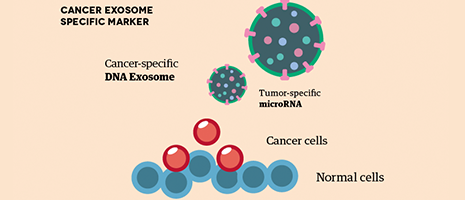Home > Highlighting JAPAN > Highlighting Japan May 2018 > Science & Technology
Highlighting JAPAN


From a Single Drop of Blood
The National Cancer Center Research Institute of Japan has developed a new diagnostic method capable of identifying thirteen types of cancer early on using microRNAs. They hope this will change the future of cancer diagnostics by detecting the illness more precisely and with minimal stress to the patient.
DEtecting cancer early lowers mortality rates and allows treatments that have a minimal impact on the mind and body. It is said that one in two people in Japan will suffer from cancer in their lifetime, yet the country’s cancer screening rates are under 50 percent—relatively low compared to other nations. According to a Cabinet Office public opinion poll, a lack of time is the major reason given for not being screened, so making the process quick and easy would have a positive impact on screening rates.
The National Cancer Center Research Institute of Japan has an answer: it’s called the AMED Body Fluid RNA Measurement Basic Technology Project, and has made fast, accurate and simple screening possible. The key to this technology is analyzing microRNAs1 (miRNAs)—RNA molecules in cells related to the symptoms and onset of diseases such as cancer, and cell multiplication. The center leads the world in demonstrating how miRNAs in the blood change in the presence of cancer.
“Cancer can be diagnosed through lab tests that spot tumor markers in the blood,” explains Takahiro Ochiya, the institute’s head of Molecular and Cellular Medicine. “Tumor markers can’t be detected until cancers are of a significant size, and diseases other than cancer can produce tumor markers, so testing for them is not a terribly reliable method of diagnosing cancer.”
According to Ochiya, the institute’s testing can detect specific miRNAs during the nascent stages of cancer, and the kind of miRNA found makes it possible to identify the type of cancer. “Just a single drop of blood—fifty microliters—is enough for a diagnosis, which is simple and only takes two days.”
Researchers found specific miRNAs for different types of cancer through comprehensive analyses of miRNAs done on blood samples from the National Cancer Center Japan’s bio bank2. Japanese manufacturers have also developed diagnostic devices that detect miRNAs, making the creation of a countrywide system of effective cancer screenings more of a reality. Building a database for miRNAs for different types of cancer and the development and basics of diagnostic technology have been settled, and the project will now enter its application phase.
The thirteen types of cancer this method can now pinpoint are gastric, esophageal, lung, liver, biliary tract, pancreatic, bowel, ovarian, prostate, bladder, breast, sarcoma and glioma. Prospective clinical research commenced in August 2017 at the National Cancer Center Hospital. Data was collected from the blood of three thousand patients diagnosed with cancer, and safety and effectiveness verifications were carried out. The center is intent on improving screening accuracy and will collect clinical data on the scale of ten thousand people within the next few years. The next step is to create an insurance-based medical service system.
“The blood-test diagnosis has only a minimal physical impact, and the estimated cost is 20,000 yen (approximately US$182),” explains Ochiya. “If medical insurance covers this testing, cancer screenings will be less expensive. All that will change cancer screenings dramatically.”
If cancer can be detected early, the treatments administered will be even more effective. In addition, greater numbers of people being able to get on with their lives even while suffering from cancer would translate to increased productivity on a national level, and lower medical costs. This is a screening method that holds tremendous promise.
Note
*1 Short RNA consisting of about twenty base pairs that regulate various biological functions. Over two thousand kinds of human miRNAs have been found so far. miRNAs are related to the symptoms of diseases such as cancer in terms of the onset of the disease and cell multiplication.
*2 Refers to both the facility and the mechanism used to store information related to medical examinations and tissue and blood specimens for medical research.
© 2009 Cabinet Office, Government of Japan







